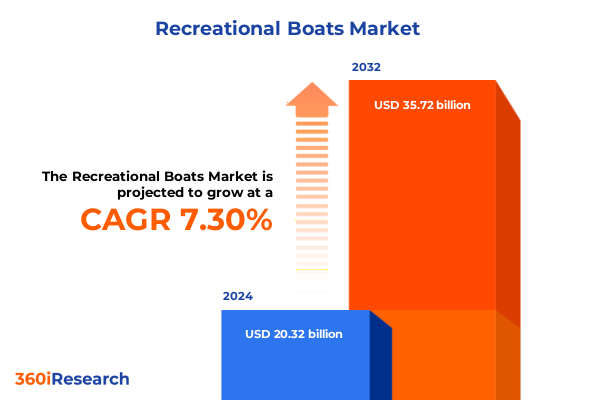The Recreational Boats Market size was estimated at USD 20.32 billion in 2024 and expected to reach USD 21.74 billion in 2025, at a CAGR of 7.30% to reach USD 35.72 billion by 2032.

Setting Sail into the Future of Recreational Boating: Embracing Post-Pandemic Resurgence, Digital Innovation, and Sustainability Trends
The recreational boating industry has experienced significant evolution, shaped by waves of consumer demand and shifting economic landscapes. Following the unprecedented surge in boat sales during the COVID-19 pandemic, the market began to normalize in 2024, with new powerboat retail unit sales estimated at approximately 231,576 units-a decline of 9.1% compared to the previous year. Despite this correction, overall boating expenditures continued to thrive, with U.S. spending projected to remain 3–5% above 2024’s anticipated $55 billion total. Amid this stabilization, industry stakeholders are refocusing on innovation to sustain long-term growth.
Charting Transformative Shifts in Recreational Boating: Electrification, Smart Connectivity and the Rise of Experience-Centric Models
The recreational boating landscape is undergoing transformative shifts propelled by technological advancements and changing consumer expectations. First, the push toward electrification is gaining momentum, as improved battery capacities and hybrid systems enable cleaner, quieter, and more efficient vessels. Advances in battery technology have extended the operational range of electric boats, prompting manufacturers to introduce models that rival traditional combustion engines in performance. Concurrently, smart connectivity is reshaping the onboard experience through IoT-enabled navigation, diagnostics, and remote monitoring, meeting the demands of tech-savvy boaters seeking enhanced safety and convenience.
Assessing the Multifaceted Impact of 2025 United States Tariff Measures on the Recreational Boating Supply Chain and Market Dynamics
The U.S. government’s 2025 tariff measures have exerted profound impacts on the recreational boating supply chain and cost structure. In early March, Section 232 tariffs on steel and aluminum imports were reinstated at a uniform 25% rate for all trading partners effective March 12, 2025, with no new exclusions granted and derivative products now subject to the same metal-content duties. This policy aimed to bolster domestic metal industries but translated into higher raw material costs for boatbuilders, who rely heavily on aluminum and stainless steel in hull and structural fabrication.
Illuminating the Intricacies of Market Segmentation by Boat Type, Size, Application and Sales Channels to Uncover Growth Opportunities
The recreational boating market can be dissected along multiple dimensions, each yielding critical insights into demand patterns and growth levers. By boat type, inflatable vessels-from rigid inflatable boats prized for durability to soft variants favored for portability-cater to a rapidly expanding adventure-sports segment. Motorboats, encompassing cabin cruisers, fishing boats, personal watercraft, pontoon boats, and speedboats, address diverse recreational and utility needs. Meanwhile, sailboats-spanning catamarans designed for stability, cruising sailboats built for comfort, day sailers for coastal excursions, and racing sailboats for performance aficionados-serve niche communities seeking specialized experiences.
This comprehensive research report categorizes the Recreational Boats market into clearly defined segments, providing a detailed analysis of emerging trends and precise revenue forecasts to support strategic decision-making.
- Boat Type
- Size
- Application
- Sales Channel
Unveiling Regional Dynamics and Growth Drivers in the Americas, Europe Middle East & Africa and Asia-Pacific Recreational Boating Markets
Regional dynamics underscore distinct opportunities and challenges across the global recreational boating landscape. In the Americas, the U.S. market recorded approximately 11 million registered recreational boats and supported over 650,000 direct industry jobs in 2024, reflecting its status as the world’s largest leisure boating economy. Despite tariff pressures and normalization of post-pandemic demand, American consumers continue to invest in on-water experiences, buoyed by robust infrastructure and a high penetration of personal watercraft.
This comprehensive research report examines key regions that drive the evolution of the Recreational Boats market, offering deep insights into regional trends, growth factors, and industry developments that are influencing market performance.
- Americas
- Europe, Middle East & Africa
- Asia-Pacific
Spotlighting Key Companies and Strategic Initiatives Propelling Innovation, Sustainability and Competition in the Recreational Boating Sector
Leading industry players are forging paths in sustainability, technology, and customer engagement. Brunswick Corporation’s expansion of smart boat portfolios-integrating advanced automation and AI navigation-drove a 28% surge in connected boat sales in 2023, illustrating the appeal of real-time diagnostics and remote operation features. Yamaha’s 2024 launch of an all-electric personal watercraft captured over 22% interest from eco-conscious urban consumers, signaling broader shifts toward low-emission leisure solutions. Meanwhile, Beneteau’s 2024 hybrid propulsion partnership reduced yacht emissions by 45%, aligning with an uptick in environmental regulation and buyer preference for greener boating experiences.
This comprehensive research report delivers an in-depth overview of the principal market players in the Recreational Boats market, evaluating their market share, strategic initiatives, and competitive positioning to illuminate the factors shaping the competitive landscape.
- A. H. Wadia Boat Builders
- Aberton Yachts Ltd.
- American Airboat Corporation
- Apache Powerboats
- Azimut Benetti S.p.A.
- Bavaria Yachtbau GmbH
- BENETEAU SA
- Bertram Yachts LLC
- Bombardier Recreational Products Inc.
- Brunswick Corporation
- Catalina Yachts
- Chaparral Boats, Inc. by Marine Products Corporation
- Diamondback Airboats, LLC
- Ferretti S.p.A.
- Grady-White Boats, Inc.
- Hallberg-Rassy Varvs AB
- Hobie Cat Company II LLC
- Island Packet Yachts
- Lee Shore Boat
- Malibu Boats, Inc.
- MasterCraft Boat Holdings, Inc.
- Monterey Boats
- Smokercraft Inc.
- SUNREEF VENTURE S.A.
- Sunseeker International Limited
- Viking Yacht Company
- White River Marine Group
- Yamaha Motor Co., Ltd.
- Z Nautic Group
Actionable Strategies for Industry Leaders to Navigate Market Disruptions, Seize Opportunities and Drive Sustainable Growth in Recreational Boating
Industry leaders must invest in sustainable propulsion R&D to stay ahead of tightening emissions regulations and increasing consumer demand for eco-friendly vessels. Collaboration with battery and alternative fuel technology partners can accelerate product readiness and cost optimization. Additionally, proactive engagement with policymakers and industry associations is essential to navigate tariff frameworks, secure targeted exemptions, and advocate for reciprocal trade measures that protect domestic manufacturing capabilities. Leveraging digital sales channels and peer-to-peer rental platforms will enable companies to reach new demographics and monetize fleets more efficiently. Finally, refining segmentation strategies-such as emphasizing premium sailing models in Europe and compact personal watercraft in Asia-Pacific-will ensure tailored offerings resonate across varied market landscapes.
Applying Rigorous Primary and Secondary Research Methodologies to Deliver Accurate, Insightful and Actionable Recreational Boating Market Intelligence
This report synthesizes insights derived from a rigorous blend of primary and secondary research methodologies. Primary research encompassed in-depth interviews with C-level executives, leading boatbuilders, marina operators, and logistics experts across North America, EMEA, and Asia-Pacific. Secondary research leveraged proprietary databases, government tariff schedules, industry association publications, and market intelligence platforms to ensure data accuracy and comprehensiveness.
This section provides a structured overview of the report, outlining key chapters and topics covered for easy reference in our Recreational Boats market comprehensive research report.
- Preface
- Research Methodology
- Executive Summary
- Market Overview
- Market Insights
- Cumulative Impact of United States Tariffs 2025
- Cumulative Impact of Artificial Intelligence 2025
- Recreational Boats Market, by Boat Type
- Recreational Boats Market, by Size
- Recreational Boats Market, by Application
- Recreational Boats Market, by Sales Channel
- Recreational Boats Market, by Region
- Recreational Boats Market, by Group
- Recreational Boats Market, by Country
- Competitive Landscape
- List of Figures [Total: 28]
- List of Tables [Total: 609 ]
Synthesizing Market Insights to Draw Conclusive Perspectives on Trends, Challenges and Opportunities in the Recreational Boating Industry
The recreational boating sector stands at an inflection point characterized by converging trends of sustainability, digitalization, and evolving consumer preferences. While U.S. tariff measures in 2025 have introduced cost pressures, they also underscore the importance of supply chain resilience and policy engagement. Technological innovations in electric propulsion and smart connectivity are transforming vessel performance and ownership experiences, creating avenues for differentiation and premiumization.
Connect with Ketan Rohom to Unlock Comprehensive Recreational Boating Market Research and Drive Your Strategic Decision-Making with Expert Insights
Are you ready to gain a competitive advantage in the recreational boating industry? Contact Ketan Rohom, Associate Director of Sales & Marketing, to explore how our comprehensive market research report can inform your strategic initiatives and investment decisions. With in-depth analysis, expertly curated data, and actionable insights, this report equips you to optimize product offerings, refine market positioning, and anticipate emerging opportunities. Reach out today to secure your copy and steer your organization toward sustained growth and innovation in the dynamic world of recreational boating

- How big is the Recreational Boats Market?
- What is the Recreational Boats Market growth?
- When do I get the report?
- In what format does this report get delivered to me?
- How long has 360iResearch been around?
- What if I have a question about your reports?
- Can I share this report with my team?
- Can I use your research in my presentation?




